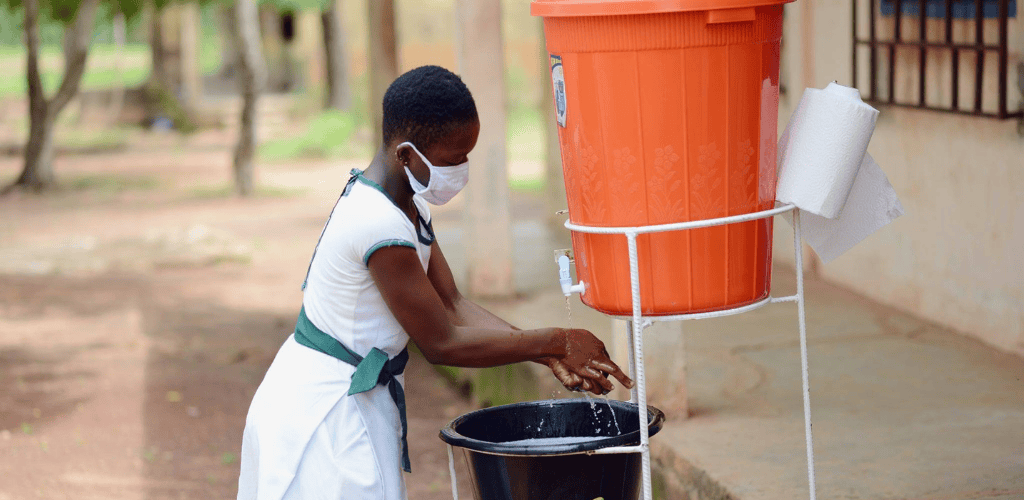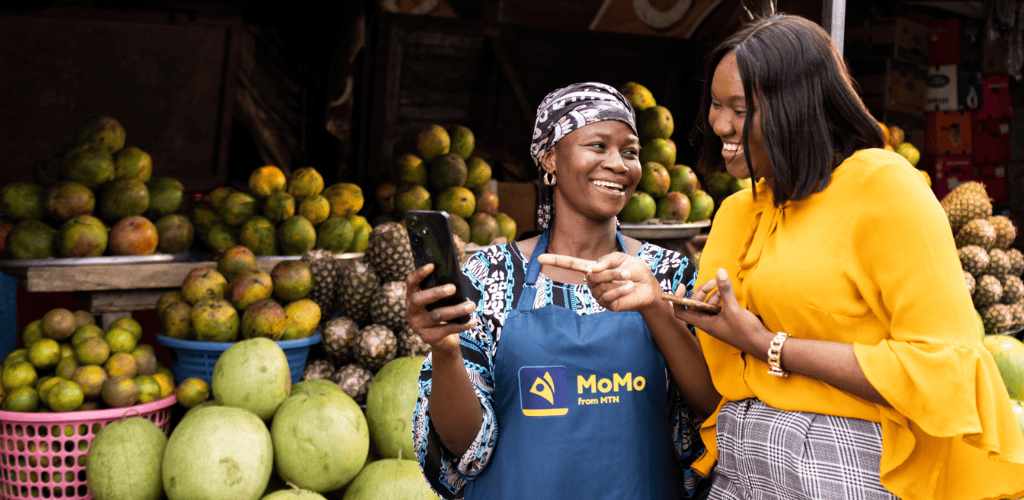Ghana’s healthcare system has seen improvements over the years, yet there are still challenges in delivering quality health services to all.
This article provides a comprehensive overview of the healthcare system, highlighting over 60 statistics and facts on various health issues, including diseases, sanitation, and health insurance.
Key takeaways
- Nearly half of Ghanaian adults are affected by hypertension, a leading cause of death.
- Non-communicable diseases such as hypertension, diabetes, and cancer account for 43% of deaths in Ghana.
- Plasmodium falciparum is the major malaria parasite responsible for most malaria-related deaths in Ghana.
- Over 330,000 people are living with HIV in Ghana, with many unaware of their status.
- Breast cancer is the second leading cause of cancer-related deaths among women in Ghana.
- Approximately 2.4 million Ghanaians are living with diabetes.
- Ghana’s infant mortality rate stands at 30.05 deaths per 1,000 live births, with rural areas experiencing higher rates.
Ghana health statistics
1. Ghana’s healthcare market is valued at US$2.4 billion. (GIPC)
In 2022, the infrastructure of Ghana’s healthcare market comprised 1,625 and 928 public and private health facilities, respectively, offering a wide range of medical products and services to the Ghanaian population.
2. Ghana’s pharmaceutical industry has a market size of US$0.44 billion. (GIPC)
As of 2021, there were over 1,000 pharmacies and 30 pharmaceutical manufacturing companies across Ghana. That same year, Ghana made US$13.69 million in pharmaceutical exports.
3. In 2023, Ghana imported US$273 million worth of pharmaceutical products. (Trading Economics)
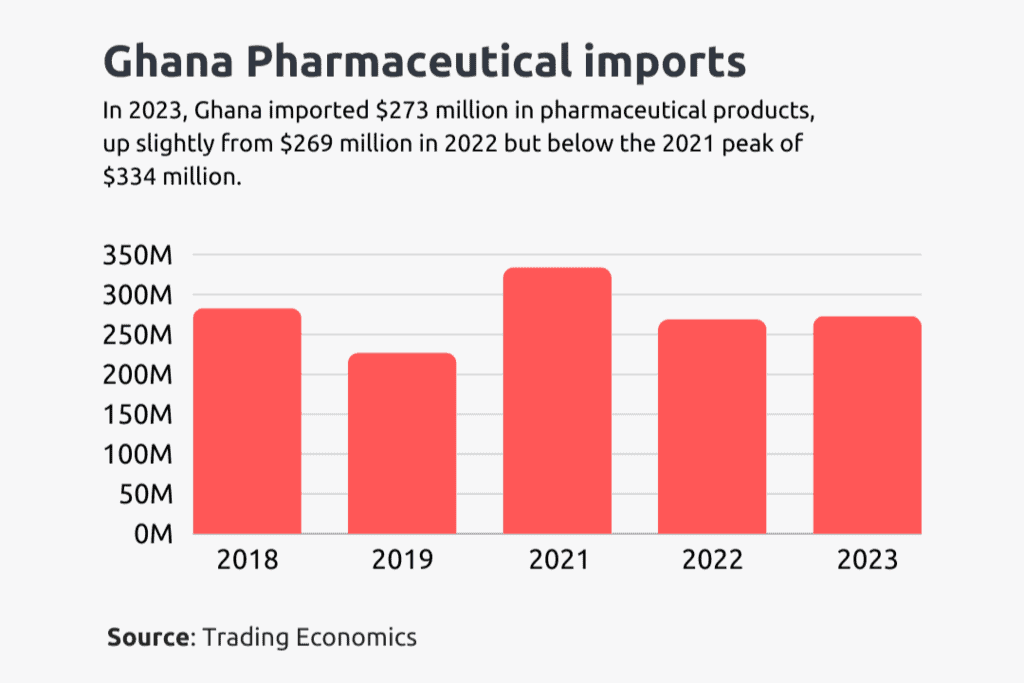
Ghana imported pharmaceutical products worth US$273 million in 2023, a slight increase from 2022’s expenditure of US$269 million. However, these figures pale compared to the most recent expenses peak of US$334 million in 2021.
4. There are 500 diagnostic centres in Ghana. (GIPC)
As of 2021, there were 500 diagnostic centres in Ghana. These centres often collaborate with other healthcare providers to improve patient care and accurately diagnose illnesses.
5. There are 356 ambulances and 3,473 EMTs in Ghana. (GIPC)
From 2004 to 2024, emergency medical technicians (EMTs) rose from 64 to 3,473, indicating a 5,426.56% increase within 20 years. Within that same period, ambulances increased from nine to 356. Recent statistics show that one ambulance services 84,000 citizens (1:84,000).
6. Ghana is expected to generate US$128.60 in revenue in the medical devices market. (Statista)
Given the recent rise in cardiovascular illnesses, cardiology devices are expected to generate the most income in 2024. Other products include orthopaedics and prosthetics, diagnostic imaging, and dental products.
7. The current life expectancy for Ghana is 65.17 years. (MacroTrends)
Ghana’s life expectancy rate has steadily increased over the past two decades due to several factors, including improved healthcare services. Between 2020 and 2024, it increased by roughly 1.16% from 64.42 to 65.17. According to projections, life expectancy is expected to hit 70.01 years by 2050.
Major diseases in Ghana statistics
8. Hypertension is the leading cause of death in most health cases. (Birth & Death Registry)
According to a 2024 report from the Births and Death Registry, hypertension was the leading cause of death in 2022, killing 1,539 men and 1,034 women. The table below shows the other major diseases in Ghana:
| Disease | Number of deaths in men | Number of deaths in women |
| Hypertension | 1,539 | 1,034 |
| Pneumonia | 1,440 | 1,017 |
| Heart failure | 1,347 | 879 |
| Acute respiratory failure | 1.162 | 1,041 |
| Stroke | 1,029 | 650 |
| Septic shock | 844 | 556 |
| Sepsis | 817 | 741 |
| Diabetes | 812 | 766 |
| Chronic liver disease | 803 | 300 |
| Cerebrovascular diseases | 519 | 357 |
| Cancer | 470 | 566 |
9. Non-communicable diseases account for 43% of deaths in Ghana (WHO)
According to the World Health Organization, non-communicable diseases (NCDS) make up 43% of deaths in Ghana. These include diseases such as hypertension, diabetes, liver disease, and cancer.
HIV/AIDS statistics in Ghana
10. Over 330,000 people are living with HIV in Ghana. (UNAIDS)
According to UNAIDS, about 338,000 people were living with HIV in Ghana as of 2023. This figure comprises approximately 320,000 adults and 18,000 children, representing 96% and 4% of Ghana’s HIV population, respectively.
11. 84.7% of persons living with HIV are aged 25 years and above. (Citi News)
Persons aged between 15-49 constitute the bulk of Ghana’s HIV population. However, adults aged between 25 years and above constitute the majority of the HIV population, with the statistics attributing most new infections and AIDS-related deaths to them.
12. Only 220,000 people living with HIV are aware of their status. (UNAIDS)

According to UNAIDS, approximately 65% of Ghana’s current HIV population is aware of their status.
13. Bono Region has the highest HIV prevalence rates in Ghana. (GNA)
In 2023, the Bono Region recorded the highest HIV prevalence rate, at 2.12%. Here are the other regions that make up the top six.
| Region | HIV Prevalence Rate (2023) |
| Bono | 2.12% |
| Greater Accra | 1.98% |
| Eastern | 1.95% |
| Western North | 1.82% |
| Ahafo | 1.79% |
| Ashanti | 1.70% |
14. North-East Region has the lowest HIV infection rates in Ghana. (GNA)
The North-East and Northern regions recorded the lowest HIV prevalence rates in 2023 with 0.43% and 0.38% respectively.
15. On average, 45% of persons living with HIV in Ghana are not on antiretroviral therapy. (UNAIDS)
Statistics show that out of the 334,095 individuals living with HIV in Ghana, about 184,095 of them are not on antiretroviral drugs. On the other hand, 44% of persons living with HIV are receiving treatment.
16. 130,000 persons living with HIV have suppressed viral loads. (UNAIDS)
According to UNAIDS, approximately 40% of HIV patients have successfully reduced their viral loads by consistently taking their antiretroviral drugs. They must continue their medication to keep the virus under control.
17. Sekyere Afram Plains District has the least number of persons living with HIV in Ghana. (GNA)
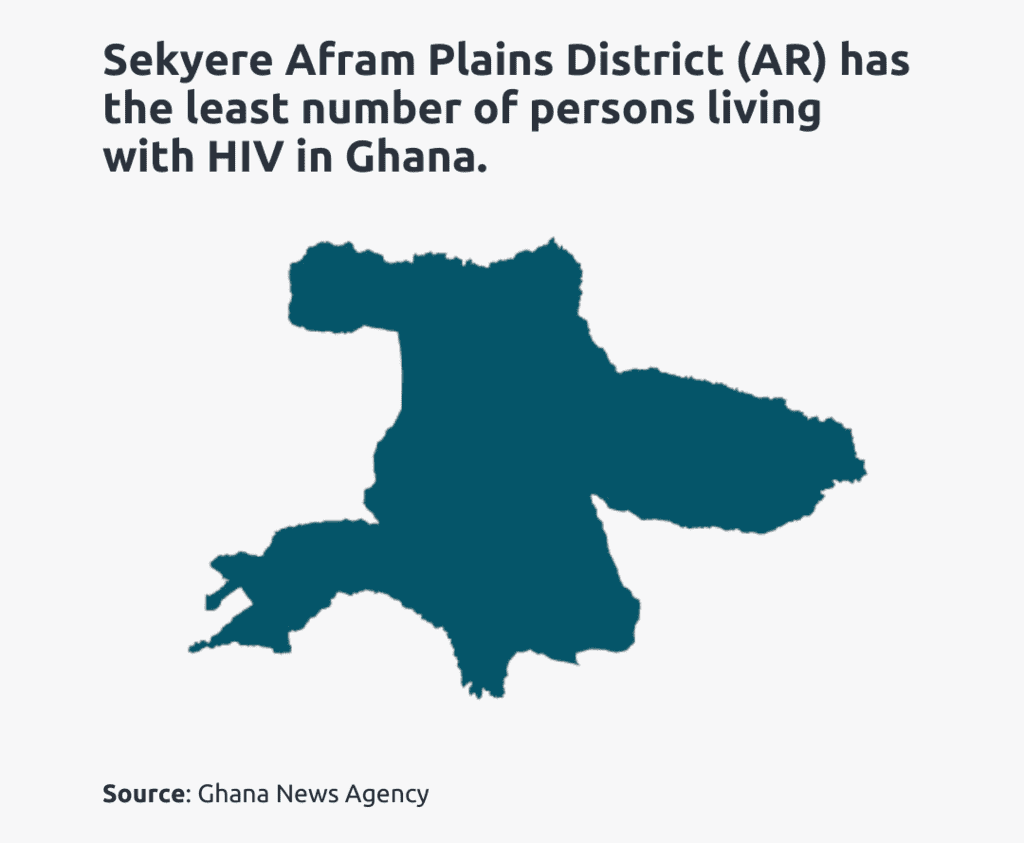
Located in the Ashanti Region, the district recorded only 11 new infection cases in 2023, according to the Ghana AIDS Commission. Afigya Kwabre North, also in the Ashanti Region, recorded 20 new infections in the same year, making it the second district with the least population of persons living with HIV.
18. Ghana’s HIV stigma index among persons living with HIV is 18.1%. (PLOS ONE)
Ghana’s HIV stigma rate is relatively high. A recent study found that 56.49% of Ghanaians were uncomfortable with the idea of allowing children with HIV to attend school and integrate with non-HIV children.
The study also found that the majority of Ghanaians said they would not purchase food from vendors with known HIV status despite knowing that the disease could not be transmitted through food.
19. Approximately 12,000 adults and children died from AIDS-related causes in 2023. (UNAIDS, Statista)
Ghana reached its peak in 2003 with 30,000 deaths. The number of AIDS-related deaths has been on a steady decline in the past two decades.
Malaria statistics in Ghana
20. Plasmodium falciparum is the major malaria parasite that has caused the most deaths in Ghana. (NMESP Report)
Plasmodium falciparum is the main parasite responsible for malaria and malaria-related deaths in Ghana, with a national prevalence rate of 98.2%.
21. Ghanaians are more likely to contract malaria during the rainy season. (NCBI)
The southern regions in Ghana typically experience two rainy seasons every year: April-June and September-November. Frequent rainfalls create a conducive environment for mosquitoes to multiply. Because of this, malaria cases in the Greater Accra Region, for example, often spike in June and July.
22. Oti Region has the highest malaria prevalence rate in Ghana. (DHS, 2022)

According to the 2022 Ghana Demographic and Health Survey, Oti Region has the highest number of malaria cases, with a prevalence rate of 15.0%. Greater Accra Region has the lowest prevalence rate of 2.0%.
23. Malaria is responsible for 20% of outpatient hospital visits. (NMESP)
In 2022, nearly a quarter of outpatient hospital visits were malaria cases. Additionally, malaria accounted for 22% of all hospital admissions.
24. Malaria affects children the most in Ghana. (NMESP)
Children between 10-14 years, representing 20.48% of the population, have the highest number of malaria cases, closely followed by children aged 5-9 years old (20%).
25. Malaria cases in children have significantly reduced in recent years. (WHO)
In 2016, 20.6% of children in Ghana were diagnosed with malaria. However, according to the Ghana Demographic Health Survey, the rate among children has dropped to 8.6% in 2023 through interventions and targeted public health campaigns.
26. Over 700,000 children have been vaccinated against malaria. (WHO)
In 2023, Ghana received US$2.2 million doses of the world’s first malaria vaccine, administered to 708,970 children across Ghana.
27. Malaria-caused deaths have reduced by 277 within a five-year window. (WHO)
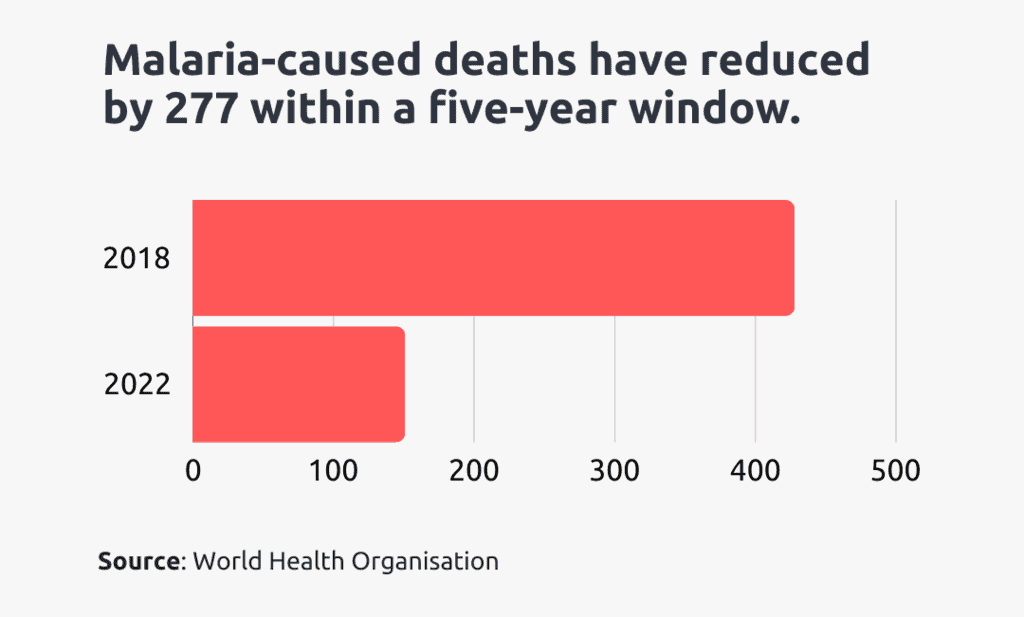
Malaria deaths in Ghana dropped from 428 to 151 between 2018-2022.
Diabetes statistics in Ghana
28. 2.4 million Ghanaians are living with diabetes. (WHO)
Diabetes has an increasing prevalence rate in Ghana, with 2.4 million Ghanaians (adults and children) living with the illness.
29. Diabetes affects 2.6%-9% of adults in Ghana. (Ministry of Health)
It is expected that the number of new diabetes cases will rise due to the lack of public health information and campaigns geared towards the Ghanaian population.
30. Western Region has the highest prevalence rate of 39.8% in Ghana. (PMC)
The Western Region has recorded the most diabetes cases, with a prevalence rate of 39.8%, closely followed by the Ashanti Region and Central Region at 25.2% and 24.6%, respectively.
31. About 10% of Ghanaians are living with diabetes. (Ghanaian Times)
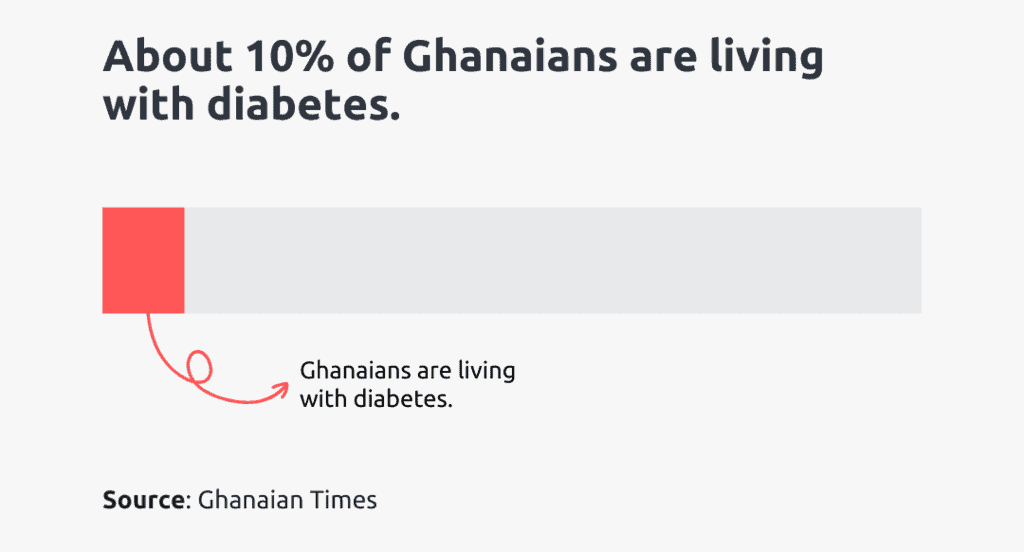
According to the National Diabetes Association of Ghana, 10% of Ghanaians representing over 300,000 of the population–are living with diabetes. The illness is more common in urban areas than in rural areas.
32. Ghana records over 200,000 diabetes cases annually. (Ministry of Health)
Diabetes is now the seventh major disease in Ghana, with healthcare facilities recording more than 200,000 new cases every year.
33. 7.5% of Ghanaians have Type-2 Diabetes. (WHO)
According to the World Health Organization, 7.5% of Ghanaians have been diagnosed with Type-2 diabetes. Due to the lack of information on the illness, it is believed there are many more Ghanaians unaware that they have diabetes.
34. The average annual cost of managing a single diabetic case in Ghana is US$194.04. (PubMed)

According to a recent study, diabetes patients pay close to US$200 every year to manage their illness at a standard outpatient clinic.
Breast cancer statistics in Ghana
35. Breast cancer is the second leading cause of cancer-related deaths in Ghana. (Global Cancer Observatory)
Breast cancer follows cervical cancer as the second major cause of cancer deaths in women living in Ghana, with 2,369 deaths in 2022.
36. 70% of women are diagnosed with breast cancer at advanced stages. (International SOS)
The majority of women do not know that they have breast cancer until it is almost usually too late. This can be due to the lack of awareness of major and minor breast cancer symptoms, cultural beliefs and influences, as well as general misconceptions about the disease. These misconceptions tend to be the fear of getting a mastectomy (surgery to remove breasts), social stigma, and the fear of dying.
37. About 5,000 women in Ghana were diagnosed with breast cancer in 2022. (Global Cancer Observatory)
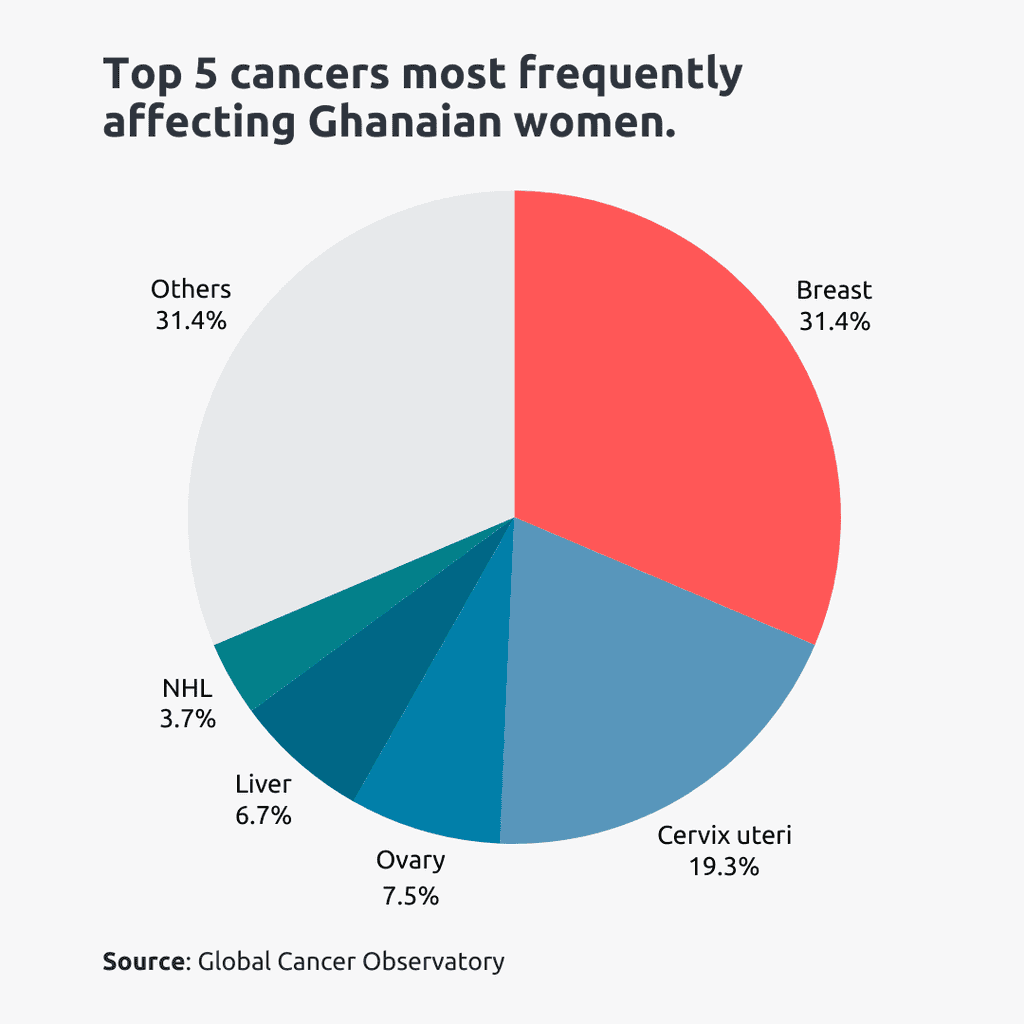
Unfortunately, many of these cases are diagnosed late, resulting in the deaths of more than half of the affected patients.
38. The average age of women with breast cancer is 47.97 years. (Research Gate, American Cancer Society)
Breast cancer is diagnosed significantly earlier in Ghanaian women, with most new cases affecting women aged 40-49 years. These statistics show that Ghanaian women are diagnosed with the illness at significantly younger ages compared to the United States, where the average age is 62 years.
Prostate cancer statistics in Ghana
39. Ghana recorded over 2,300 new prostate cancer cases in 2022. (WHO)
Prostate cancer is the second leading cancer affecting Ghanaian men, with 2,395 recorded cases in 2022 and 1,233 deaths in that same year.
40. Receiving a prostate cancer diagnosis can cost nearly GH₵7,000. (BMC Health Service Research)
A prostate cancer diagnosis can cost from GH₵1,686 – GH₵6,816 with treatment options ranging from GH₵12,000 – GH₵15,000 as of 2022.
Cervical cancer statistics
41. Over 2,700 women are diagnosed with cervical cancer in Ghana every year. (Ghana Health Service)
According to the Ghana Health Service, 2,797 women are diagnosed with cervical cancer every year. Out of this figure, 1,699 women die from the illness, representing about 60%.
42. The cervical cancer survival rate is 32.4%. (ecancer, Prostate Cancer Foundation)
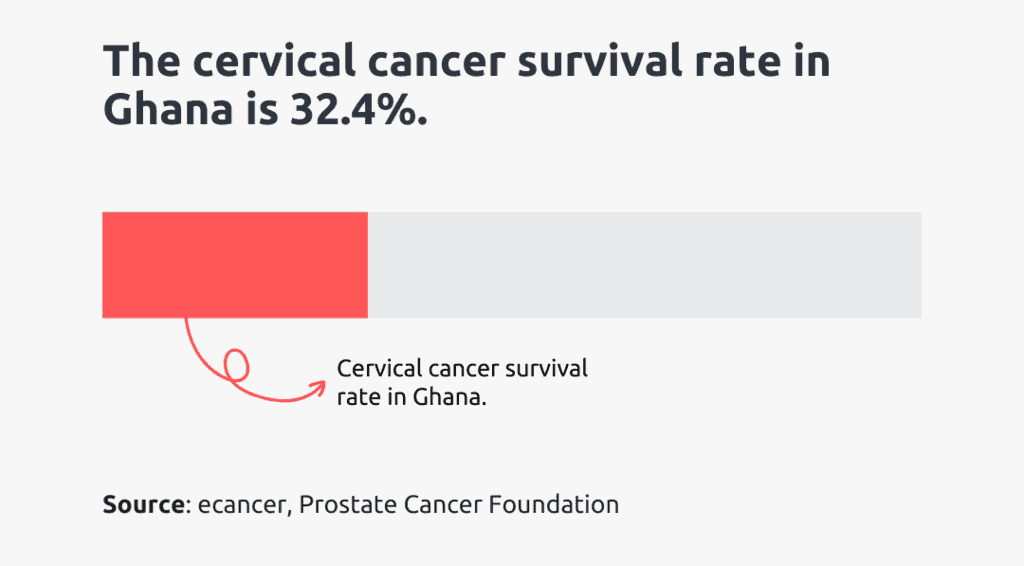
A study conducted in Ghana showed that women diagnosed with cancer had a 32.4% chance of surviving the illness five years after diagnosis. This figure is considered low compared to countries like the United States (99%) with better treatment facilities.
43. Cervical cancer kills an average of 142 women in Ghana every month. (TRT Afrika)
According to a report by the International Maritime Hospital, an estimated 233 women are diagnosed with cervical cancer every month, with more than half of them dying shortly after.
Childhood cancer statistics in Ghana
44. 1,300 children in Ghana develop cancer every year. (World Child Cancer)
According to World Child Cancer, 1,300 children living in Ghana are expected to be diagnosed with cancer every year. The major types of cancers affecting Ghanaian children include bone marrow cancer, kidney cancer, and leukaemia (cancer of the blood).
45. There are only seven trained paediatric oncologists in Ghana. (World Child Cancer)
Ghana lacks the resources for managing childhood cancer cases, with only seven trained oncologists specialising in childhood cancers. Additionally, only two hospitals, the Korle-Bu Teaching Hospital and the Komfo Anokye Teaching Hospital, can provide complete patient care.
46. In Ghana, 20% of children diagnosed with cancer will survive the illness. (WHO)
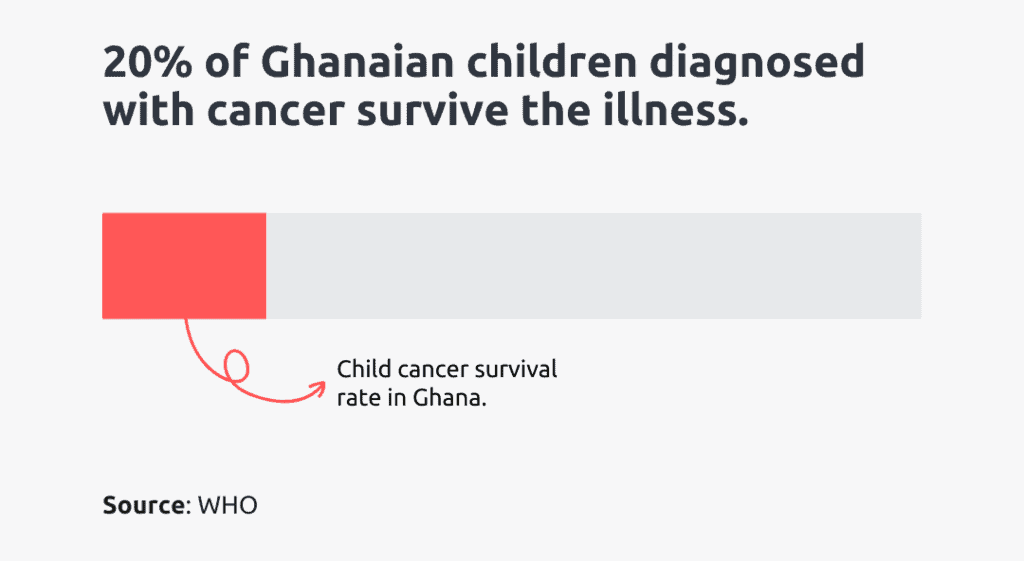
In Ghana, only 20% will survive due to late diagnosis, lack of resources, and a relatively expensive treatment cost.
47. About 85% of children have completed cancer treatment. (WHO)
According to the WHO, since 2018, 85% of children living with cancer and undergoing treatment have completed treatment compared to 50% in 2010.
Premature deaths statistics in Ghana
48. Ghana’s infant mortality rate is 30.049 deaths per 1,000 live births. (MacroTrends)
Ghana has recorded a steady decline in infant mortality rates over the past four years, as presented in the table below:
49. Northern Ghana has the highest child mortality rates in Ghana. (BioMed)
Research shows that 111 children die for every 1,000 live births in Northern Ghana, compared to just 47 deaths per 1,000 in Greater Accra. These figures indicate the wide gap between medical care in rural and urban centres in Ghana.
50. Acute respiratory distress is the leading cause of death in children under five in Ghana. (Wiley Online Library)
Following respiratory diseases, premature births, sepsis, diarrheal diseases, and congenital disabilities are some of the major causes of death in children under five.
Hypertension statistics in Ghana
51. Nearly half of Ghanaian adults have hypertension. (Frontiers)
Studies show that about 50% of adults living in Ghana are hypertensive as of 2022.
52. 19% of Ghanaians have controlled their hypertension. (WHO)
For Ghana to achieve a controlled rate, 1.1 million adults with hypertension need to be on regular treatment. According to the World Health Organization, women are receiving treatment for their hypertension more than men.
53. Only 36 out of 100 people take medication. (World Heart Federation)
36% of people aware of their status are on medication to regulate and control their hypertension.
54. 600,000 people are diagnosed with hypertension every year. (World Heart Federation)
Statistics show that about 400,000 women and 200,000 receive a hypertension diagnosis annually in Ghana. There is the likelihood that the numbers could be higher, as many people are unaware of their hypertension.
Sanitation statistics in Ghana
55. 25% of Ghanaians have access to basic sanitation services. (UN)
According to the United Nations Water, Sanitation, and Hygiene (UN WASH) programme, only a quarter of the Ghanaian population can access basic sanitation. More than half of Ghanaians use public sanitation facilities.
56. 18% of Ghanaians openly defecate. (UN)
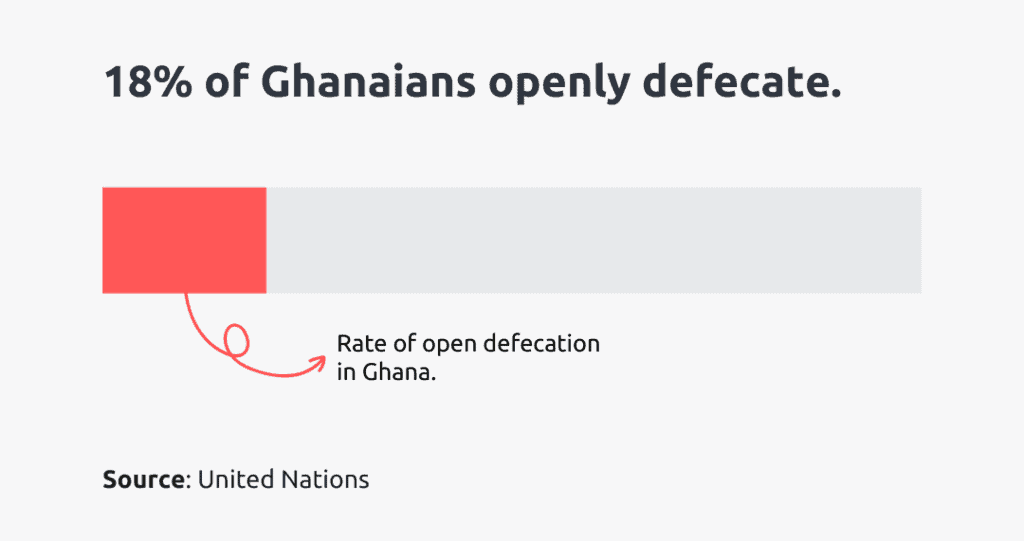
Open defecation puts Ghanaians at risk of contracting communicable diseases such as cholera, diarrhoea, and typhoid.
57. Ghana recorded over 7,000 deaths related to sanitation in 2019. (UN)
According to the UN WASH programme, 7,653 deaths recorded in Ghana were due to illnesses caused by poor sanitation practices.
58. 42% of Ghanaians have access to safe drinking water. (UN)
Nearly half of the Ghanaian population has access to clean drinking water, which is still lower than the global average but higher than many other countries in sub-Saharan Africa.
Ghana Health Insurance statistics
59. Ghana has a diverse health insurance landscape, with 20 schemes operating in the country. (NHIS, GHS Report)
Ghana’s health insurance sector is mainly dominated by the private sector, comprising 12 licensed private insurance schemes, seven licensed private commercial schemes, and one licensed private mutual health scheme.
60. In 2021, 68.6% of Ghanaian citizens had health insurance. (Ghana Statistical Service)
The 2021 Ghanaian census reported that 68.6% of Ghanaians were either on the National Health Insurance Scheme (NHIS) or a private health insurance scheme.
61. There are more women on health insurance than men. (Ghana Healthcare Insurance, Statista)
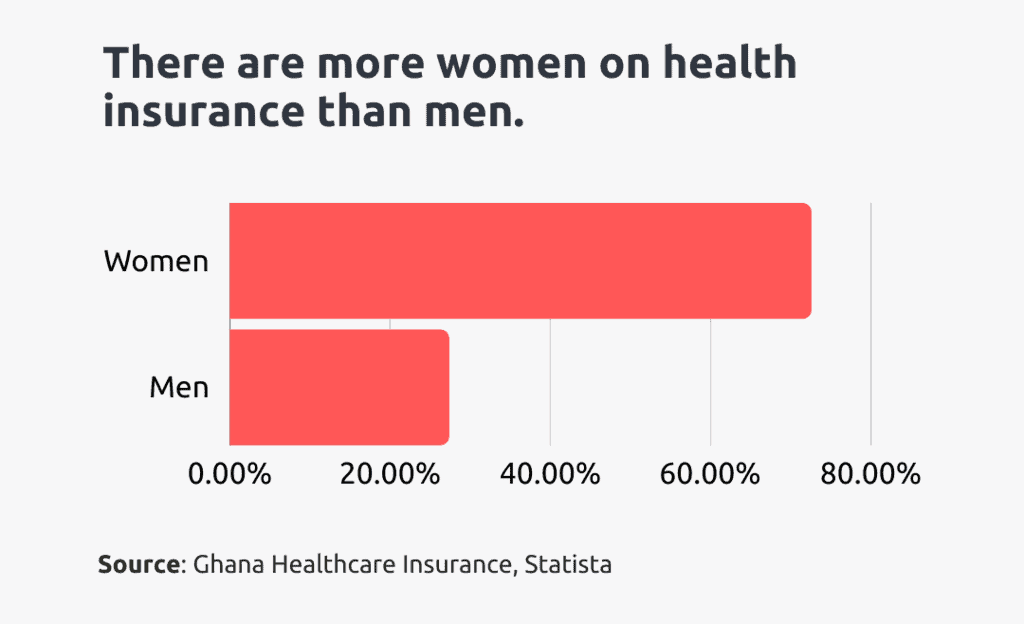
According to the 2021 Ghana census report, 72.6% of women were on a health insurance scheme.
62. 16.75 million Ghanaians are registered with the National Health Insurance Scheme. (NHIA)
16.75 million Ghanaians, representing 54% of the total population, were enrolled in the NHIS in 2021.
63. The NHIS covers 95% of illnesses in Ghana. (NHIA, NHIS)
The NHIS covers the costs of most medical services in Ghana, including numerous out-patient and in-patient services, oral health, eye care services, and maternity.
In 2022, childhood cancers, family planning, and a breast cancer treatment drug were included in the scheme. However, the NHIS doesn’t cover other services like cosmetic surgery, dialysis, cancer treatment, premium medical treatment, and organ transplantation.
Conclusion
Ghana’s healthcare system continues to improve, with efforts being made to combat health challenges such as malaria, HIV/AIDS, and cancer. However, the burden of non-communicable diseases such as hypertension and diabetes remains.
This highlights the urgent need for improvements in healthcare infrastructure and public health education. What additional steps can be taken to improve healthcare in Ghana further? Share your suggestions with us in the comments section.
